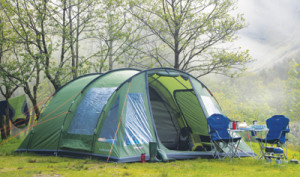By Fiona at SimplyHike.uk

“Undo the guyline and pop it on to the peg other there,” I shout to my 10-year-old daughter as she insists on helping me to put up the family tent at the start of our week-long trip to Perthshire.
“The guy line?” she questions. “The what line?.. And why is it called a guy?”
I come round to her side of the tent that is still half lying on the ground, half upright and mostly billowing in the wind and point to the length of cord attached to the tent that is actually called a guyline. “Ah,” she says. “The bright green string thing. I get it now.”
“That’s right, loosen off the knot and then put the end loop around the peg,” I add.
“Where is the peg,” says my daughter, looking at eye level and all over the outside of the tent.
“It’s the metal hook thing that I have hammered into the ground. Look, down there. It’s called a tent peg… And, no, I don’t know why! It doesn’t look much like a peg, now I come to think of it!”
If you’re new to the world of tents and camping holidays here are a few more tent terms you might like to know about.
Tent bits and the stuff you need to know
A ground sheet: This is more obvious and is, as you’d imagine, the layer of hopefully waterproof tent material that sits inside the tent and on the ground. Many campers now also buy carpet for their tents. Essentially the groundsheet or carpet keeps the damp ground out so that you can sit or sleep in dry comfort.
The poles, which look like poles should, and come in a variety of sizes and lengths. Many of today’s tent poles fold down on themselves when not in use and then slot together when the tent is being erected. Amazingly, bendy poles seem to be increasingly in use and provide the main frame for the tent.
Canvas: Today’s tents aren’t usually made from canvas. I can recall my dad’s old Scout tent being made of real canvas and I can still conjure up the smell of a damp canvas tent. Today, the canvas has been replaced by strong and waterproof nylon mix materials.
Mallet. This is a rubber-topped hammer and generally used for banging tent pegs into the ground and occasionally for whacking your thumb.
Guy runner: This is the igneous plastic gadget that allows you to lengthen or shorten the guyline to suit the tent shape, position and uprightness.
The inner tent is the main body of the tent that forms the walls, ceiling and floor of the structure. Inner tents are made of lightweight and breathable fabrics.
The flysheet is the outer, waterproof covering layer to the tent. The flysheet is made from a heavier material than the inner.
Air vents help to reduce the effects of condensation. Condensation is caused inside the tent when a person breathes. This breathing expels quite a lot of water vapour and if the outside of the tent is colder than the inside, which is usually the case, then the water vapour will condense on the inside of the tent. Air vents help to control condensation by letting the air escape.
Tents come in different shapes including domes, tunnels, A-frames, pop-ups and cabins.
A bivi-bag is a kind of tent except it’s more like a sleeping bag! A bivi-bag is lightweight and very transportable and fits neatly over your sleeping bag with minimal requirement for poles and pegs.
Peg extractor. For taking pegs out of the ground and avoiding the mud-in-nails unpleasantness.
Mallet: This is like a hammer but has a softer head and is perfect for banging pegs into the ground.
Have we missed anything vital to do with tents and bits and pieces?
Fiona Russell is an outdoors,fitness and health writer. She works for a range of traditional press and on-line publications. She somehow manages to live the dream, combining her love of the outdoors with a full-time job and family.









Recent Comments